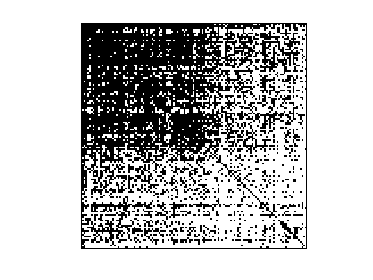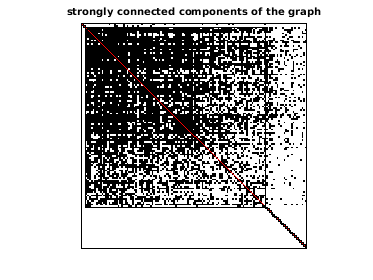SNAP/email-Eu-core
SNAP network: email-Eu-core network
| Name |
email-Eu-core |
| Group |
SNAP |
| Matrix ID |
2784 |
|
Num Rows
|
1,005 |
|
Num Cols
|
1,005 |
|
Nonzeros
|
25,571 |
|
Pattern Entries
|
25,571 |
|
Kind
|
Directed Graph With Communities |
|
Symmetric
|
No |
|
Date
|
2007 |
|
Author
|
J. Leskovec, J. Kleinberg and C. Faloutsos |
|
Editor
|
J. Leskovec |
| Structural Rank |
|
| Structural Rank Full |
|
|
Num Dmperm Blocks
|
|
|
Strongly Connect Components
|
203 |
|
Num Explicit Zeros
|
0 |
|
Pattern Symmetry
|
71.1% |
|
Numeric Symmetry
|
71.1% |
|
Cholesky Candidate
|
no |
|
Positive Definite
|
no |
|
Type
|
binary |
| Download |
MATLAB
Rutherford Boeing
Matrix Market
|
| Notes |
SNAP (Stanford Network Analysis Platform) Large Network Dataset Collection,
Jure Leskovec and Anrej Krevl, http://snap.stanford.edu/data, June 2014.
email: jure at cs.stanford.edu
email-Eu-core network
https://snap.stanford.edu/data/email-Eu-core.html
Dataset information
The network was generated using email data from a large European research
institution. We have anonymized information about all incoming and outgoing
email between members of the research institution. There is an edge (u, v)
in the network if person u sent person v at least one email. The e-mails
only represent communication between institution members (the core), and
the dataset does not contain incoming messages from or outgoing messages to
the rest of the world.
The dataset also contains "ground-truth" community memberships of the
nodes. Each individual belongs to exactly one of 42 departments at the
research institute.
This network represents the "core" of the email-EuAll
(https://snap.stanford.edu/data/email-EuAll.html) network, which also
contains links between members of the institution and people outside of the
institution (although the node IDs are not the same).
Dataset statistics
Nodes 1,005
Edges 25,571
Nodes in largest WCC 986 (0.981)
Edges in largest WCC 25552 (0.999)
Nodes in largest SCC 803 (0.799)
Edges in largest SCC 24729 (0.967)
Average clustering coefficient 0.3994
Number of triangles 105461
Fraction of closed triangles 0.1085
Diameter (longest shortest path) 7
90-percentile effective diameter 2.9
Source (citation)
Hao Yin, Austin R. Benson, Jure Leskovec, and David F. Gleich. "Local
Higher-order Graph Clustering." In Proceedings of the 23rd ACM SIGKDD
International Conference on Knowledge Discovery and Data Mining. 2017.
J. Leskovec, J. Kleinberg and C. Faloutsos. Graph Evolution: Densification
and Shrinking Diameters. ACM Transactions on Knowledge Discovery from Data
(ACM TKDD), 1(1), 2007.
http://www.cs.cmu.edu/~jure/pubs/powergrowth-tkdd.pdf
File Description
email-Eu-core.txt.gz
Email communication links between members of the institution
email-Eu-core-department-labels.txt.gz Department membership labels
Data format for community membership
NODEID DEPARTMENT
NODEID: id of the node (a member of the institute)
DEPARTMENT: id of the member's department (number in 0, 1, ..., 41)
---------------------------------------------------------------------------
Notes on inclusion into the SuiteSparse Matrix Collection, July 2018:
---------------------------------------------------------------------------
The SNAP grqph is 0-based with nodes numbered 0 to 1004.
In the SuiteSparse Matrix Collection, Problem.A is the directed graph,
where A(i,j)=1 if person 1+i sent person 1+j at least one email.
(1+, since the SNAP graph is 0-based).
Each person is in exactly one community, so this could be represented
as a vector of size n, as node meta data. However, to be consistent
with the other SNAP/com-* problems in the SuiteSparse Matrix
Collection, the community structure is represented as a sparse matrix,
created from the file email-Eu-core-department-labels.txt.
C = Problem.aux.Communities_all is a sparse matrix of size n by 42.
C(i,k)=1 if person 1+i is in department 1+k (again, 1+ to convert
the data to 1-based). Thus, column C(:,k) represents the (1+k)th
community, where each community is a member's department.
|

